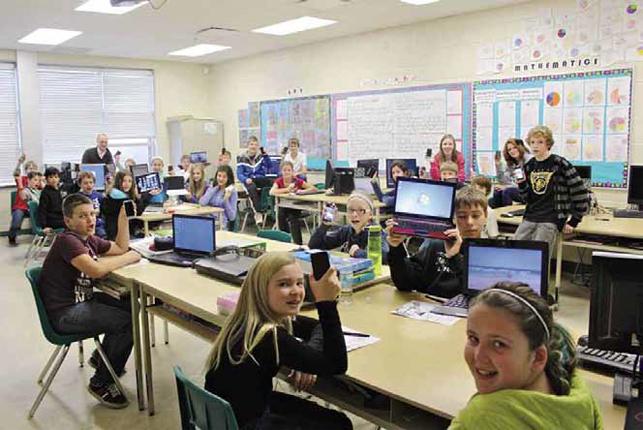
The Cloud in the Classroom: The Plugged-In Portable
In addition to traditional computers, students in my classroom use mobile devices as learning tools to collaborate, investigate, innovate, and express themselves creatively. While students use these devices almost instinctively, teachers may struggle to understand their relevance to teaching and learning. School boards face infrastructure and budgetary hurdles. Here is how our “Plugged-In Portable” has attempted to overcome these two major obstacles.
Lack of computers
I have more than a dozen computers in my portable. My situation doesn’t represent the typical classroom, but lack of computers doesn’t have to be an obstacle if we begin to harness the computing power of student-owned mobile devices such as the iPod Touch and smartphones. The cost of allowing these devices in the classroom is exceptionally low. By surveying our students, my learning coordinator and I found that a large portion of students already own an iPod and regularly bring it to school.
Although many teachers may still be unsure about the use of mobile devices in the learning environment, I have been explicitly teaching and modelling for my students how to use them in a socially responsible, safe, and ethical manner. Therefore, students in my classroom don’t use cellphones to text each other or make calls during lessons.
In making use of mobile devices in the classroom, I am not simply pandering to students’ interests. Technology facilitates learning. Using mobile devices represents a feasible solution to the lack of computers. If you are unfamiliar with mobile devices, using them to teach might seem a daunting task with a steep learning curve. When we flip the tables and ask our students to teach us, we begin to cultivate an environment that exemplifies positive interdependence. I believe the potential is there if you choose to tap into this learning paradigm.
Managing multiple operating systems in the cloud
Opening the door to student-owned devices, means facing the challenge of dealing with a number of computing platforms in our classrooms.
Using cloud computing and Web 2.0 applications, we can meet this challenge and provide students with rich opportunities for collaboration on nearly any Web-enabled device. At any given time, my students can be working simultaneously on a document using iPods and computers running multiple operating systems.
The Google suite of applications makes it possible. The only must-have is access to a Web browser. All students have free Google accounts and can access all of Google’s cloud-based applications (e.g., word processing and spreadsheets).
They can “check in” with the class while on vacation and submit assignments, or can collaborate on documents in real time with the rest of the class while home ill. My students also use a variety of other Web-based applications, such as Prezi, Bitstrips, and Glogster.
Cloud computing and Web 2.0 are transforming the way students learn and challenging educators to rethink outdated pedagogy. By removing the barriers of having to access software applications stored on our school network running one operating system, the option of learning anytime, anywhere is truly at our students’ fingertips.
Observations
My experience in the “Plugged-In Portable” has profoundly changed my role as a classroom teacher. The most striking example of this change occurred early in the school year.
Shortly after I introduced students to a new software application,they started to approach each other, rather than me. I witnessed this gradual release of responsibility frequently, as it didn’t usually take long for students’ knowledge to surpass mine. They became the experts and the teachers, and I became a coach as I roamed the classroom providing suggestions and encouragement, and pushing their thinking. This doesn’t diminish my role – it simply recasts what it means to be a teacher in the twenty-first century. By the end of the year, my students were learning as much from me as from each other and the amount of face-to-face and online collaboration, investigation, and innovation was profound.
Blog: http://thepluggedinportable.edublogs.org/
Twitter: @pluggedportable
Email: d.carruthers@tvdsb.on.ca

